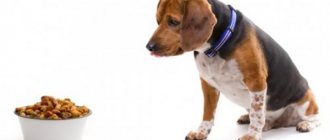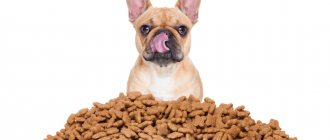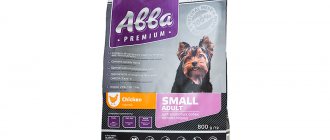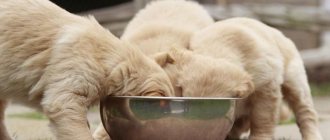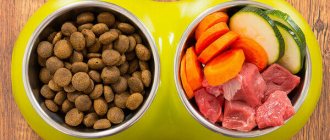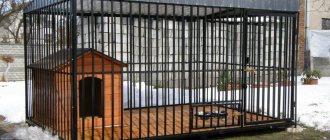How many times a day should you feed your dog?
Considering the above, let's figure out how much to feed an adult dog per day and according to what schedule.
Adult dog
As a rule, an adult dog is fed 2 times a day - morning and evening. This schedule, among other things, is also convenient, because many people go to work in the morning and return only in the evening.
Of course, you can feed the dog 3 times a day, which some owners do. This cannot be called wrong, but it is not recommended to feed more than three times a day.
Puppy
Answers to questions about how many times to feed a dog at 8 months, at 6 months, at 4 months, etc. will be different. But in general, the point is that the younger the puppy, the more times a day he needs to be fed. For exact numbers on the number of feedings, see the table below.
Puppy age How many times to feed Feeding schedule
| 1-2 months | 6 times a day | At 7:00, 10:00, 13:00, 16:00, 19:00, 22:00 |
| 2-3 months | 5 times a day | At 7:00, 10:00, 14:00, 18:00, 22:00 |
| 3-4 months | 4 times a day | At 7:00, 12:00, 17:00, 22:00 |
| 4-6 months | 3-4 times a day | At 7:00, 12:00, 17:00, 22:00 |
| 6-10 months | 3 times a day | At 7:00, 13:00, 21:00 |
| From 10 months | 2 times a day | At 7:00, 21:00 |
From this table it is clear that puppies are transferred to the feeding schedule for adult dogs at ten months of age. That is, we already feed our one-year-old dog only twice a day.
It should be noted that the indicated schedule and number of feedings are approximate, so nothing bad will happen if, for example, the first feeding is carried out at 8 am, and switches to the adult schedule at 8 months.
Pregnant dog
How many times to feed a pregnant dog depends primarily on the due date. In the early stages, there is no need to change the feeding schedule or greatly increase the diet, otherwise the problem of excess weight may arise.
It is very important to provide a good diet during pregnancy, because puppies need a lot of nutrients for their development. Under no circumstances should you feed your pregnant dog cheap dry food (Pedigree, Darling, Our Brand, etc.), they will not even come close to providing her body with everything it needs.
How to calculate the daily allowance
When your dog eats dry food, there are no problems determining the daily intake, because it is always indicated on the package. Usually in the form of a sign in which the feeding rate is indicated opposite the dog’s weight. All that is required is to know the weight of your pet and divide the indicated norm by the number of feedings per day. This will give you the volume of a single serving.
Note that these numbers can be significantly higher when it comes to pets with high physical activity. Also, the volume of portions depends on the prepared dishes, because, for example, porridge with vegetables has less calories than meat.
A natural food diet should include:
- meat (30-50%);
- vegetables (15-20%);
- cereals (25-35%);
- fish;
- dairy products (20-30%)
- fruits.
In general, to ensure your pet gets enough nutrients, include everything listed above in his diet. See what exactly you can use from dairy products in the article “what to feed your dog at home”; it also says what cereals, meat, etc. you can eat. Remember that you cannot feed your pet, for example, only cereals, because then he will at least lack proteins.
By the way, do you have any advice from personal experience on how much to feed a dog per day? Then don’t forget to share them below, it will be very useful for many novice dog breeders.
"Dai Lapu" website
On the pages of our website you will find information about dog breeds, treatment for diseases, care recommendations, reviews of ready-made food and feedback on them, as well as much other equally useful and interesting things!
Dog nutrition - what are the food standards?
Depending on the age, breed and physical activity of the dog, its diet changes. How to determine the rate of food consumption to provide your pet with the necessary substances and microelements, we will consider further.
Meal frequency
If puppies eat constantly and willingly from the moment of birth, then from the age of three months it is necessary to accustom them to a certain diet. Gradually the number of feedings is increased to the following amount:
- age 3-6 months – 3-4 doses;
- from 6 to 12 – 2-3 times a day;
- from one year and older – 1-2 doses.
The schedule is based on the fact that as an animal gets older, it eats less often.
If the food is natural, then the amount of food required to satiate the dog can be determined experimentally. The norm of industrial feed is calculated according to the instructions on the pack.
Types of industrial feeds
Industrial feeds are divided into four main types:
- Dry. Water content – from 2 to 8%, high energy value. The use of such food reduces the risk of developing tartar, but its constant use threatens to wear off the enamel. Suitable for individuals older than 9-12 months after complete replacement of milk teeth, requires control of water consumption.
- Wet. The water content is from 40 to 60%, so the risk of dehydration of animals is minimal. The food has a low energy value compared to dry food. With constant use, due to the minimal load on the gums, it leads to their loosening and diseases of the oral cavity. Suitable for feeding dogs of any age.
- Semi-moist. It consists of pieces in sauce or jelly and has the same characteristics as wet food.
- Treats – chewy treats, cookies and other items.
In addition to types, industrial feeds are divided into classes that differ both in cost and in the balance of ingredients used in their production:
- Economy class. They have the lowest calorie content - 250-300 kJ per 100 g of product.
- Premium class. Such foods contain a large amount of plant carbohydrates and can be dangerous for allergy sufferers, but they are optimal for daily use, their calorie content is 300-350 kJ.
- Super premium class. The feed is balanced in terms of the content of proteins, vitamins, and microelements; optimal for regular use; calorie content – 360-450 kJ.
- Holistic class. With excellent balance, it is comparable to the super-premium class, but in its production higher quality raw materials are used, calorie content - 360-450 kJ.
The recommended combination of different types of feed in the daily diet is 75% dry and 25% wet. Recommendations for dosage depending on the weight of the pet and its activity can be read in the instructions on the pack.
Different types of food (dry or wet) cannot be mixed in one meal; their consumption must be separated.
Dog's need for natural food
If in industrial food all the elements are balanced and the amount of its consumption is determined in the instructions, then in the case of natural food you need to independently control the content of the necessary substances. You should adhere to the following layout in your daily diet:
- meat products – 40%-50%;
- fermented milk – 20%-30%;
- fiber – 20%-30%.
In addition, it is necessary to treat your pet with vegetables and unsweetened fruits.
In order not to overfeed your dog, you should determine the norm of its daily diet. It is usually calculated this way:
- puppies up to six months – 6% of the animal’s weight;
- dogs older than 6 months – 3-4%.
How to tell if your dog is full
An important indicator of a dog being in good shape is maintaining its weight. Active behavior during physical activity also indicates the absence of overeating, balance and caloric content of the diet.
When feeding, the dog practically does not feel full and eats until the food runs out. But even when the bowl is empty, the dog does not immediately leave, but asks for more. To avoid overeating and establish the norm, it is necessary to monitor the animal:
- A dog has eaten enough when, without receiving more, it leaves and goes to bed.
- A dog is hungry if it constantly circles around an empty bowl. In this case, you should increase the feeding rate, reconsider the food balance, or show your pet to a veterinarian.
Types of dog food
All foods vary in type and class. The class of food refers to its quality, or more precisely, the quality of the raw materials from which it is made. One class and brand of food may include several types of food.
The following types of feed are distinguished:
- Dry – granules.
- Wet - pate.
- Semi-moist - pieces with gravy or jelly.
- Treats – tablets, crackers, medallions, chewy treats, etc.
Dry food is intended for feeding puppies after complete teething and adult dogs.
Wet and semi-wet food is intended for feeding puppies, miniature and elderly dogs; they are not contraindicated for animals of any age and size.
What is the difference between types of food, if we consider products of the same brand and line? Difference in water content.
Dry food contains from 2% to 8% water; in wet food, the figure can range from 40% to 60%.
Interesting! All wet and semi-moist foods are completely similar in composition, but the pates have a completely uniform consistency (they do not need to be chewed).
What type of food is best to feed a dog? If the animal does not have an indication for a certain type of nutrition for health reasons, the choice is completely voluntary. But! When choosing the type of feeding, you need to consider the following aspects:
- With wet foods, which are usually more expensive than dry foods, you pay about half the cost for water.
- When feeding wet food, the risk of dehydration is minimal.
- When feeding dry food, the risk of tartar formation is reduced.
- Feeding exclusively dry food leads to rapid abrasion of tooth enamel, which is fraught with caries and toothache.
- Feeding wet food reduces the load on the gums, which leads to their loosening, as a result, to periodontal disease and other diseases of the oral cavity.
Important! Food manufacturers and veterinarians recommend a diet for adult dogs consisting of 75% dry and 25% wet food.
On the recommendation of a veterinarian or the owner’s desire, the proportion of wet food can be increased. However, keep in mind that the energy value of wet food is several times lower than dry food.
How to calculate a dog's diet using a table?
The question of how to calculate a dog’s diet often arises before owners. This may be necessary to protect your pet from overeating without leaving him hungry, or to stock up on provisions for a specific period.
Feeding standards when using a commercial diet for a dog have already been determined by the manufacturer and are clearly marked on the packaging. As a rule, they are presented in the form of a table, where several gradations by weight are provided. Sometimes recommendations are also given for animals of different ages and activity levels.
Calculation of feeding rates for dog diets "Akana" and "Origen"
Let's take as an example a table compiled for feeding dogs the Acana Wild Prairie Dog diet from the Regionals line, which consists of 70% animal products.
As you can see, to calculate a dog’s diet, you don’t need a calculator or complex mathematical operations. All you need to know is your pet’s current weight and activity level.
Dogs with one or more hours of physical activity in their lives should eat as recommended in the "Increased Activity" column.
For the rest, the norm indicated in the right column - “Reduced activity” will be enough.
Feeding dosages for puppies of different ages, pregnant and lactating dogs are listed at the bottom of the table:
- at 1–3 months, puppies need double the norm of an adult dog of the corresponding weight, at 3–6 months it needs to be increased by 50%, at 6–11 months - by 25%;
- in the first half of pregnancy, the dog requires the norm calculated by weight, plus 25% on top, in the second half of pregnancy - plus 50%;
- During lactation, the amount of food a four-legged mother can eat is not limited. Dry food is left freely available and the bowl is refilled as soon as it is empty.
Examples
A low-active 30-kilogram dog requires 240 g of food, an active one - 360 g.
The puppy is 2.5 months old and weighs 2 kg. Its norm is: 40 * 2 = 80 grams.
A pregnant dog weighing 10 kg in the early stages needs 150 + 25% = 187.5 g, in the later stages: 150 + 50% = 225 g.
Please note: all calculated norms are not one-time, but daily.
Also keep in mind that ready-made diets of different brands are not the same in nutritional value, so for calculations you need to use exactly the table that is printed on your food packaging.
Information on Acana and Orijen products for dogs is always available on our website. Each diet has its own page, which presents a table of feeding rates, the composition of the feed and its detailed description.
Every dog is unique
It is important to understand that the manufacturer’s recommendations regarding feed dosages are average indicators. The actual needs of animals may be slightly higher or lower, depending on age, health, temperament and external conditions.
For example, watchdogs living outside need more food during the cold season than their counterparts living in warm apartments. Older animals, on the contrary, often have to cut back on their diet.
The need for food is also reduced after sterilization (castration) surgery, as well as in case of certain hormonal disorders.
To avoid overfeeding, monitor your dog's shape and weigh him monthly if possible. In addition, the dog’s build can be determined with your hands: with a normal weight, the ribs should be clearly palpable, but not protruding.
If you see that your dog is losing weight or gaining weight on the recommended diet, it is advisable to adjust the food dosage by 10–20% in one direction or another.
In cases where this does not help, it is wise to seek advice from a veterinarian.
Need help calculating your dog's diet? Contact our consultant via feedback chat. We are waiting for your messages.
Recommended feeding rates
Experienced owners understand how important it is to maintain an animal’s optimal weight, and are able to recognize in time the moment when it begins to get fat. But for those who have a four-legged friend for the first time, it can be difficult to decide how much dry food the dog needs and how often to fill the bowl.
Those owners who act wisely weigh their pet regularly and adjust the amount of food depending on the dynamics of weight. But in any case, a certain reference point is necessary - the optimal amount of dry food so as not to overfeed the dog and not leave him hungry.
Manufacturers of ready-made diets always provide such information on food packages. As a rule, it is presented in the form of a table, which contains recommendations for animals with different body weights.
Amount of dry dog food
The dosage of dry food should be taken responsibly - you should not uncontrollably fill the bowls to the brim, because you usually cannot rely on your pet’s sense of proportion. The topic of our conversation today will be the amount of dry food for a dog: what it depends on and how it is adjusted.
Table of daily norms and needs of different dogs
In order to determine the size of the food portion, you first need to know the dog’s weight, at least approximately. Regularly weighing your pet will help adjust this norm to a comfortable value so that the dog does not overeat and is full at the same time.
If we know the dog’s weight, we can use a table of daily food intake - such a table is always published on the official pages of food brands on the Internet and, of course, on each package. As an example, consider Blitz Adult Lamb & Rice food for all breeds.
Dog weight Recommended norms for low activity, g / day Recommended norms for high activity, g / day
| 1 kg | 20-35 | 30-40 |
| 3 kg | 45-55 | 50-70 |
| 5 kg | 75-90 | 80-120 |
| 10 kg | 125-150 | 145-170 |
| 15 kg | 175-200 | 190-240 |
| 20 kg | 220-260 | 250-300 |
| 30 kg | 280-350 | 330-400 |
| 40 kg | 380-440 | 430-500 |
| 50 kg | 450-525 | 520-590 |
| 60 kg | 520-605 | 600-670 |
| 70 kg | 580-680 | 670-770 |
| 80 kg | 650-750 | 740-850 |
In his table, in addition to weight, there is also an indicator such as activity, which must also be taken into account.
After all, a dog with the same weight may have different energy needs: a 10-kilogram dog kept in apartment conditions will need 130 grams of food per day, but an active, mobile dog with the same weight will need more to replenish energy costs. 150–170 grams.
The nutritional needs of puppies and older dogs differ. During the period of active growth, puppies require a colossal amount of energy, so the easiest way is to use dry food from the Puppy series, which has a higher calorie content than food for adult dogs, for example Blitz Puppies Fresh Duck & Chicken.
The energy needs of aging dogs are much more modest than those of young dogs. Age-related changes, which include a slowdown in metabolic processes, make the dog less active and prone to weight gain.
It is not necessary to look for special food for older dogs; besides, older pets often have established eating habits and may react negatively to a new taste.
It is enough to simply slightly reduce the daily intake of your usual dry food.
How many feedings per day does a dog need?
Puppies should be fed often, but little by little, divided into several feedings. As the puppy gets older, the number of feedings decreases, and at about one year of age the animal can switch to an “adult” feeding regimen - twice a day. We talked in more detail about how to feed puppies and juniors in this article.
Allowance for dry food for an adult dog
- To find out the optimal amount of dry dog food that an animal should eat during the day, you can consult a veterinarian, or you can independently calculate it using a tablet, taking into account your pet’s weight and its activity.
Weight and activity
For dogs that lead a different lifestyle from their brothers (participating in competitions, pregnant and lactating, working and hyperactive), the portion should be calculated a little differently.
| Features of the animal | Increasing or decreasing portions |
| Service and participating in competitions | + a third of the serving |
| Pregnant and lactating bitches | + a quarter of the portion |
| Elderly and inactive | - a third of the serving |
How much food does a dog need per day?
How many dry granules a dog needs per day is far from an idle question. After all, the best effect from feeding a dry diet is achieved only with proper consumption.
The composition of the food is strictly calculated (at least for high-quality premium food and higher), and the division into groups according to the age, size and physical activity of the dog is made for a reason.
Each brand has a feeding chart on the back of the package. It indicates how many grams should be given to the dog per day depending on its weight (puppy food also has age restrictions).
How do you know if there is enough food?
To ensure that your pet has enough energy and nutrients without an excess of them, be sure to follow these standards. After observing the dog for a week, you can increase or decrease the dose, but only slightly. It is impossible to exceed the norm by two (or even three) times.
If you think that 250 grams per day is very little for your pet, fill the food with water and then see how much it swells. It increases to the same size in the gastrointestinal tract.
In addition, the concentration of nutrients per 100 grams of food is much higher than in the natural food you were fed before.
Monitor your pet's condition. On good dry food with normal physical activity, animals do not get fat, but maintain the correct body weight. If within a week or two feedings you notice that your dog has gained weight, this means:
- incorrect amount of feed. Ask yourself if you put more into the bowl than necessary, succumbing to the hypnotic gaze of a hungry dog. As mentioned above, the daily norm is calculated by specialists; when it is exceeded, the body begins to make reserves on the sides.
- wrong choice of food. All feeds are divided into groups and differ in the percentage of nutrients.
By mistakenly purchasing food for puppies or active service dogs, your pet will consume a diet with more protein and fat than it needs. Accordingly, body weight increases.
Foods for small breeds are higher in calories than foods for medium and large dogs.
- low physical activity. Even if the food is suitable for your pet, a decrease in physical activity compared to the usual regimen will cause excess weight. For example, in the heat, the dog walks and runs less, but he has not lost his appetite. In the end, I ate the same amount, but spent much less energy.
- low quality food. Economy class diets contain few animal proteins; they will mainly contain cheap fillers such as wheat and corn (products harmful to dogs). You yourself understand that if you eat a lot of wheat, you gain weight instantly.
The same goes if your pet is losing weight. Wrong quantity (not enough), wrong variety, etc.
How to measure the right amount of granules?
At the pet store, along with a bag of food, you can buy a measuring cup from the same company (usually they give them for free). On the cup you will find a column corresponding to the type of food purchased. This column contains numbers indicating grams.
Look at the table on the packaging, pour into the glass up to the indicated number in the required column - this will be the required amount.
Since a plastic glass is not very durable, you can additionally measure the correct level in the bowl, this will be more convenient.
How much water should a dog drink?
Calculating the required amount of water is very simple. There should be two, two and a half times more water than dry food. For example, the daily drying rate is 300 grams, i.e. 600-800 g of water will be required.
But there is no need to force your pet to drink if he doesn’t want to. It is enough for him to always have fresh and clean water available.
Remember to monitor the bowl, if the dog drinks too little (as much as the food he ate or less), add something tasty to the water, such as broth.
As you can see, it is very simple to determine the required feeding rate with a dry diet; you just need to know a few rules.
Ekaterina Titova (Doggy Center instructor)
How much food to give a dog: calculating the daily intake
One of the most common questions about feeding a dog is how much food does it need per day? What is the optimal rate for a dog to feel good?
In order to answer this seemingly simple question, you need to know what breed or size the dog is, its age, gender, physical condition, living conditions and activity level. Only by comparing all the data can we say how much food to give the dog daily.
When creating our food, we try to take into account the parameters of dogs as much as possible, creating lines not only for dogs of a certain size and age, but also for a specific level of stress and health status. The daily ration amount is always indicated on the packaging of our food. You can also check the table on the website. And based on this, calculate the amount of food per meal for your dog.
When determining the daily diet for their dog, each owner must understand that the norm will be individual, even if several dogs of the same breed live in the house, because each dog’s body is also individual.
So how do you determine how much food your dog needs per day? For an active dog, the daily food intake will be higher than for a passive one. For a puppy or young dog, the number of feedings and volume of food will also be greater than for an older dog. For an animal that is sick or is in the period of rehabilitation after an illness, the number of feedings and volume will also be different.
With more frequent feedings, the diet should be nutritious, but the volume of each feeding should be small. The amount of daily ration for kennel dogs living in difficult climatic conditions or performing heavy physical work, for example, northern sled dogs, border dogs and police dogs, should also be increased.
It is important to know that the more nutritious food you offer your dog, the smaller its volume should be. Otherwise, the dog, especially if it is a pronounced food eater, will suffer from overeating. And this, in turn, can lead to obesity. This is important to remember when determining how much dry food your dog needs.
If you notice that your dog doesn’t have enough of the norm it needs, it doesn’t leave the bowl, it’s losing weight, which means that either its loads do not correspond to the nutritional value of the diet you have chosen, or you need to add more food or increase the frequency of feedings if the dog is young.
When a dog constantly asks for food, shows increased interest in food at its usual feeding rate, but its physical condition is satisfactory, this is a reason to consult a veterinarian, as these signs may indicate hormonal disorders.
How much dry food does a dog need per day?
The amount of dry dog food per day is important for any owner. If the dog receives less food, he will be weakened and vulnerable to disease, if more, there is a risk of developing obesity. Thus, both under- and overfeeding are equally harmful for the dog, and only if you stick to the golden mean will your pet feel really good. But how do you know exactly how much dry food a dog needs per day?
Calculation of the daily intake of dry dog food
To determine the daily rate of feeding a dog with dry food, you need to know the age and exact weight of the dog. In addition, the size of the animal, its lifestyle (active/domestic), character and breed play a role.
Keep in mind that feeds of different classes have different levels of energy value, which also affects the calculations. For example, super premium food is usually higher in calories than economy class food.
So how much dry food should you give your dog per day? The answer is usually contained directly on the packaging of the food you purchased: manufacturers write how much of their product a dog needs per day, based on its size. True, these are still average standards - you may have to give your pet a little more food, or a little less.
Daily dog food requirements: approximate values
If we talk about the average daily amount of premium food (moderate calorie content), the table for adult animals will look like this:
- Large dogs - from 35 kilograms in weight - will need 400-600 grams of dry food per feeding;
- Medium dogs - 15-35 kilograms - will need 300-400 grams of food per day;
- For small dogs - up to 15 kilograms - 150-300 grams of food will be sufficient, and it is recommended to divide this portion into two parts; this is important for small breeds.
Keep in mind that very active animals - for example, service dogs or athletes - require a special feed calculation, as well as for pregnant or lactating animals. To the daily food allowance calculated according to usual standards, you need to add another 1/3 serving for working dogs and 1/4 for pregnant women.
But if the dog is elderly or does not move much, you should reduce the usual portion by about 1/4. This is very important for preventing obesity.
How much food does a dog need per day? Calculation for puppies
Everything that is said above applies to adult dogs, but puppies have completely different “standards”.
Young animals are actively growing and, of course, they need more nutrients than already mature dogs. Accordingly, the daily food intake for a puppy under the age of 6-7 months should be 1.
5 times the norm for an adult dog of the same size and weight. This portion is divided into 4-6 meals.
In order for your pet to feel really good, choose only the food that suits him. The consultants of our online store are ready to help you with this. Call!
Feeding dry food depending on the size of the pet
Obviously, the amount of dry food for dogs of large and small breeds is different. It will not be difficult to calculate how much your pet will need. Select your dog's weight and read the approximate calculation.
For small breeds
The daily norm for adult small breeds (weighing up to 15 kg) is 300-400 g of food if we are talking about economy class, and 150-300 g if you give your pet premium.
An animal weighing 15-35 kg should consume 400-600 g of low-grade food or 300-400 g of a premium product.
For large breeds
These include dogs weighing 35-65 kg. Large breed animals need to be fed with plenty of food. Give them either 400-600 g of premium food or 600-800 g of economy food.
For your maximum convenience, we provide above a detailed table that clearly and clearly outlines how much dry food to give your dog per day.
How much dry food does a dog need? — online store of goods for animals Vetna
How much dry food does a dog need?
August 15, 2020
Standards for feeding dogs dry food
– individual indicators.
They depend on several factors:
- feed class,
- dog size,
- physiological state,
- activity,
- age.
Industrially produced feeds are conventionally divided into 4 classes, which differ in the quality of ingredients used in production, balance, nutritional and energy value (Kcal/100g).
- Economy class
feed has an energy value of 250-300 Kcal. They are made from low quality products and require the introduction of vitamin and mineral supplements into the diet.
- Premium class
has a nutritional value of 300-350 Kcal. Its advantage is an increase in the amount of animal proteins in the form of by-products and waste, as well as the inclusion of vitamins and microelements.
- Super-premium
food is a balanced, complete diet suitable for regular feeding. Energy value 360-450 Kcal.
- Holistic class
food with an energy value of 360-450 Kcal differs from super-premium class in that they are produced from the highest quality products approved for the food industry.
Thus, the amount of dry dog food per day for super-premium class will be slightly less than the volume of economy-class food due to its high nutritional and energy value.
Feeding frequency
Puppies are fed more often than adult dogs. This rule applies to any type of nutrition.
- Pet's age Number of feedings
- 1-2 months 5-6 feedings per day
- 2-3 months 4-5 times a day
- 4-6 months 3-4 times a day
- from 6 months up to one year 3 meals
- over 1 year 2 meals (morning and evening)
Serving size for adult dogs
- The portion is calculated based on the dog’s weight and activity.
- Daily feeding rates
- Body weight Active lifestyle Low activity level
- 1 hour or more physical Less than one hour physical
- loads per day (grams/day) loads per day (grams/day)
- 2 kg 60 30
- 5 kg 90 60
- 10 kg 160 120
- 20 kg 280 180
- 30 kg 390 240
- 40 kg 480 320
- 50 kg 560 360
- 60 kg 640 420
The packaging of any food, regardless of class, must indicate the recommended serving size. It may differ slightly from what is shown in the table.
Active animals, service dogs or athletes, need special consideration, as well as pregnant and lactating animals. To the usual dosage of dry dog food, approximately 1/3 of the serving is added for working dogs and 1/4 for pregnant women (from the 5th week of pregnancy) and lactating. If the dog is elderly and inactive, the portion should be reduced by about 1/3.
Standards for feeding puppies dry food
The main indicator when determining the norm of feeding puppies with dry food is the energy value, or calorie content. This allows you to correctly calculate the daily portion and determine the quality and digestibility of the feed. A puppy needs energy from food for growth and development. The average feeding rate of dry food by age is presented in the table.
| Puppy age | Daily norm per 1 kg of weight |
| up to 1 month | 210–220 kcal |
| 1–3 months | 260–270 kcal |
| 3–4 months | 200–210 kcal |
| 4–8 months | 130–140 kcal |
| 8–12 months | 100–110 kcal |
Each puppy develops and grows individually, so calorie calculations should be adjusted. The dimensions of the rock have a particular influence. Typically, the manufacturer indicates the energy value per 100 g of product on the food packaging. To determine servings, you need a kitchen scale or measuring cup marked with the daily value.
